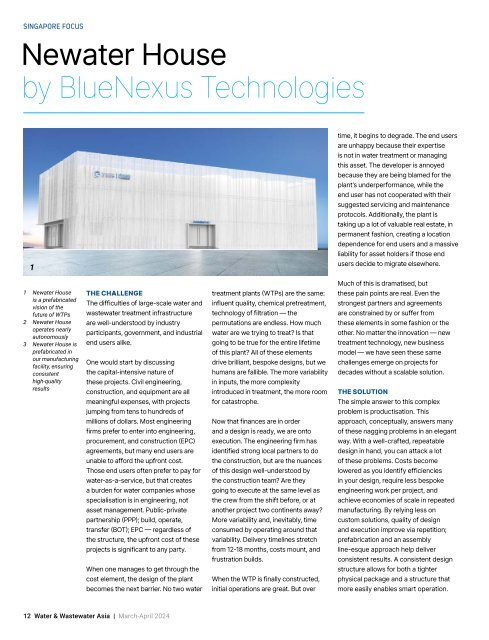Water & Wastewater Asia March/April 2024
Water & Wastewater Asia is an expert source of industry information, cementing its position as an indispensable tool for trade professionals in the water and wastewater industry. As the most reliable publication in the region, industry experts turn this premium journal for credible journalism and exclusive insight provided by fellow industry professionals. Water & Wastewater Asia incorporates the official newsletter of the Singapore Water Association (SWA).
Water & Wastewater Asia is an expert source of industry information, cementing its position as an indispensable tool for trade professionals in the water and wastewater industry. As the most reliable publication in the region, industry experts turn this premium journal for credible journalism and exclusive insight provided by fellow industry professionals. Water & Wastewater Asia incorporates the official newsletter of the Singapore Water Association (SWA).
You also want an ePaper? Increase the reach of your titles
YUMPU automatically turns print PDFs into web optimized ePapers that Google loves.
SINGAPORE FOCUS<br />
Newater House<br />
by BlueNexus Technologies<br />
time, it begins to degrade. The end users<br />
are unhappy because their expertise<br />
is not in water treatment or managing<br />
this asset. The developer is annoyed<br />
because they are being blamed for the<br />
plant’s underperformance, while the<br />
end user has not cooperated with their<br />
suggested servicing and maintenance<br />
protocols. Additionally, the plant is<br />
taking up a lot of valuable real estate, in<br />
permanent fashion, creating a location<br />
dependence for end users and a massive<br />
liability for asset holders if those end<br />
1<br />
users decide to migrate elsewhere.<br />
Much of this is dramatised, but<br />
1 Newater House<br />
is a prefabricated<br />
vision of the<br />
future of WTPs<br />
2 Newater House<br />
operates nearly<br />
autonomously<br />
3 Newater House is<br />
prefabricated in<br />
our manufacturing<br />
facility, ensuring<br />
consistent<br />
high-quality<br />
results<br />
THE CHALLENGE<br />
The difficulties of large-scale water and<br />
wastewater treatment infrastructure<br />
are well-understood by industry<br />
participants, government, and industrial<br />
end users alike.<br />
One would start by discussing<br />
the capital-intensive nature of<br />
these projects. Civil engineering,<br />
construction, and equipment are all<br />
meaningful expenses, with projects<br />
jumping from tens to hundreds of<br />
millions of dollars. Most engineering<br />
firms prefer to enter into engineering,<br />
procurement, and construction (EPC)<br />
agreements, but many end users are<br />
unable to afford the upfront cost.<br />
Those end users often prefer to pay for<br />
water-as-a-service, but that creates<br />
a burden for water companies whose<br />
specialisation is in engineering, not<br />
asset management. Public-private<br />
partnership (PPP); build, operate,<br />
transfer (BOT); EPC — regardless of<br />
the structure, the upfront cost of these<br />
projects is significant to any party.<br />
When one manages to get through the<br />
cost element, the design of the plant<br />
becomes the next barrier. No two water<br />
treatment plants (WTPs) are the same:<br />
influent quality, chemical pretreatment,<br />
technology of filtration — the<br />
permutations are endless. How much<br />
water are we trying to treat? Is that<br />
going to be true for the entire lifetime<br />
of this plant? All of these elements<br />
drive brilliant, bespoke designs, but we<br />
humans are fallible. The more variability<br />
in inputs, the more complexity<br />
introduced in treatment, the more room<br />
for catastrophe.<br />
Now that finances are in order<br />
and a design is ready, we are onto<br />
execution. The engineering firm has<br />
identified strong local partners to do<br />
the construction, but are the nuances<br />
of this design well-understood by<br />
the construction team? Are they<br />
going to execute at the same level as<br />
the crew from the shift before, or at<br />
another project two continents away?<br />
More variability and, inevitably, time<br />
consumed by operating around that<br />
variability. Delivery timelines stretch<br />
from 12-18 months, costs mount, and<br />
frustration builds.<br />
When the WTP is finally constructed,<br />
initial operations are great. But over<br />
these pain points are real. Even the<br />
strongest partners and agreements<br />
are constrained by or suffer from<br />
these elements in some fashion or the<br />
other. No matter the innovation — new<br />
treatment technology, new business<br />
model — we have seen these same<br />
challenges emerge on projects for<br />
decades without a scalable solution.<br />
THE SOLUTION<br />
The simple answer to this complex<br />
problem is productisation. This<br />
approach, conceptually, answers many<br />
of these nagging problems in an elegant<br />
way. With a well-crafted, repeatable<br />
design in hand, you can attack a lot<br />
of these problems. Costs become<br />
lowered as you identify efficiencies<br />
in your design, require less bespoke<br />
engineering work per project, and<br />
achieve economies of scale in repeated<br />
manufacturing. By relying less on<br />
custom solutions, quality of design<br />
and execution improve via repetition;<br />
prefabrication and an assembly<br />
line-esque approach help deliver<br />
consistent results. A consistent design<br />
structure allows for both a tighter<br />
physical package and a structure that<br />
more easily enables smart operation.<br />
12 <strong>Water</strong> & <strong>Wastewater</strong> <strong>Asia</strong> | <strong>March</strong>-<strong>April</strong> <strong>2024</strong>

















